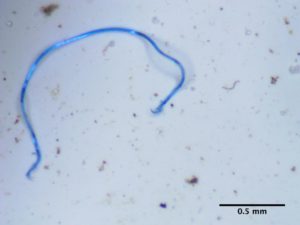 Suburban deer enjoying Memorial Day weekend.
Suburban deer enjoying Memorial Day weekend.
Doesn't matter if plants are considered deer resistant or not - they eat them all!
Health, Microbes, and More

 Suburban deer enjoying Memorial Day weekend.
Suburban deer enjoying Memorial Day weekend.
Doesn't matter if plants are considered deer resistant or not - they eat them all!
 The usual medical advice to take non-prescription anti-inflammatory drugs (e.g., Advil, Aleve, aspirin) or steroids for pain and inflammation from an injury may actually backfire down the line. A recent study found that blocking inflammation from an injury actually causes an increase in pain and inflammation 3 months later (may become chronic pain), and which is harder to treat.
The usual medical advice to take non-prescription anti-inflammatory drugs (e.g., Advil, Aleve, aspirin) or steroids for pain and inflammation from an injury may actually backfire down the line. A recent study found that blocking inflammation from an injury actually causes an increase in pain and inflammation 3 months later (may become chronic pain), and which is harder to treat.
The McGill University researchers found that drugs that inhibit inflammation interfere with the natural recovery process, thus increasing the odds for chronic pain. They found that neutrophils (a type of white blood cell that helps the body fight infection) play a key role in resolving pain.
"Neutrophils dominate the early stages of inflammation and set the stage for repair of tissue damage. Inflammation occurs for a reason, and it looks like it's dangerous to interfere with it," said Professor Mogil, one of the researchers.
The researchers looked at lower back pain and temporomandibular disorder (TMD) and found that the results appeared to hold for both mice and humans.
Bottom line: After an injury such as lower back pain, non-prescription medicines that only block pain are OK to take, for example, Tylenol (Acetaminophen) . It's the anti-inflammatory medicines that could lead to persistent (chronic) pain three months later. View inflammation as part of the healing process - don't want to interfere with that.
Excerpts from Medical Xpress: Discovery reveals blocking inflammation may lead to chronic pain
Using anti-inflammatory drugs and steroids to relieve pain could increase the chances of developing chronic pain, according to researchers from McGill University and colleagues in Italy. Their research puts into question conventional practices used to alleviate pain. Normal recovery from a painful injury involves inflammation and blocking that inflammation with drugs could lead to harder-to-treat pain. ...continue reading "Blocking Inflammation After An Injury Can Result In Persistent Pain"

This is a good time to reflect on the state of the Earth. One huge problem is the amount of plastic garbage being generated every year, including single use plastic bags. This has led to the problem of plastics and tiny plastic particles (from plastics degrading) now found everywhere in the environment - including the air, water, our food, and in us. Microplastics are even in our lungs and blood!
Some facts to consider:
It turns out that just twenty companies are the source of more than 50% of single use plastic items (bottles, bags, food packages) that are thrown away. Globally. Number 1 is ExxonMobil, and Dow is number 3. The full list of companies is published by the Plastic Waste Makers Index.
The list is of the top 100 companies in the plastic supply chain. They manufacture polymers - known as the building block of plastics. These 100 companies are responsible for over 90% of single-use plastics generated globally. Single-use plastics are made almost exclusively from fossil fuels (coal, oil, and natural gas).
The future: More states are passing single-use plastic bag bans, which apply to grocery stores (e.g., California, NY, NJ). Expect to see this policy spread to other states. Expect bans to eventually occur globally.
From CNBC.com, originally published May, 2021: Just 20 companies are responsible for over half of ‘throwaway’ plastic waste, study says
...continue reading "Are Particles of Single Use Plastic Bags In Your Body?"
 HAPPY EARTH DAY!
HAPPY EARTH DAY!
Support and protect our Earth. It's our only one.
 A large recent study found that commonly used erectile dysfunction drugs (e.g. Viagra, Cialis, Levitra, and Stendra) are associated with an increased risk for 3 types of vision problems: serious retinal detachment (SRD), retinal vascular occlusion (RVO), and ischemic optic neuropathy (ION).
A large recent study found that commonly used erectile dysfunction drugs (e.g. Viagra, Cialis, Levitra, and Stendra) are associated with an increased risk for 3 types of vision problems: serious retinal detachment (SRD), retinal vascular occlusion (RVO), and ischemic optic neuropathy (ION).
Keep in mind that these are rare vison problems and the risk of developing these problems was elevated in regular users of erectile dysfunction (ED) medications. These ED drugs are phosphodiesterase type 5 inhibitors (PDE5Is). Those who developed these eye problems were also more likely to have hypertension, diabetes, coronary artery disease, and sleep apnea.
Bottom line: Regular users of erectile dysfunction medications should contact their eye care provider if they develop unusual eye symptoms.
From Medical Xpress: US insurance claims show strong link between erectile dysfunction medications and vision problems
The risk of developing one of three serious eye conditions increases by 85 percent for regular users of common erectile dysfunction (ED) medications such as Viagra, Cialis, Levitra and Stendra, new UBC research has found.
Two of the three conditions had previously been linked to ED medications only by anecdotal case studies. Those links are now confirmed for the first time by a large, epidemiological study, published today in JAMA Ophthalmology. ...continue reading "Erectile Dysfunction Medications and Increased Risk of Some Eye Problems"

More news about microplastics (tiny plastic particles) and where they are showing up in humans. Yesterday's post was about microplastics showing up in human blood, and today's post is about a study finding microplastics deep in the lungs of living people.
Yes, not only do we ingest microplastics in our food and water (especially from water bottles), but we also inhale microplastics in the air. This is worrisome because microplastics accumulate in the body, and at this point long term effects are unknown.
Our bodies are not filtering and getting rid of many of the plastic microparticles that we ingest or breathe in (yes, some also get excreted in our feces). No one thinks this is good, and some early study results are showing harm. Some concerns include inflammation, increased risk of cancer, alterations of the microbiome, endocrine disrupting effects from the chemicals in the microplastics.
 The 13 people in the study were undergoing surgery (that's a good time to take samples of lung tissue) in the UK. Samples from 11 people found microplastics, with the most common being polypropylene (in plastic packaging and pipes) and PET (in bottles). The images of microparticles in the lung tissue samples are actually horrifying because it is clear they do not belong there!
The 13 people in the study were undergoing surgery (that's a good time to take samples of lung tissue) in the UK. Samples from 11 people found microplastics, with the most common being polypropylene (in plastic packaging and pipes) and PET (in bottles). The images of microparticles in the lung tissue samples are actually horrifying because it is clear they do not belong there!
By the way, some earlier studies also found microplastics in human lungs. Microplastics are a result of plastic breaking down or shedding tiny particles.
Excerpts from The Guardian: Microplastics found deep in lungs of living people for first time
Microplastic pollution has been discovered lodged deep in the lungs of living people for the first time. The particles were found in almost all the samples analysed. ...continue reading "Microplastics Found Deep In the Lungs of People"
 Tiny particles of plastic, called microplastics, have now been detected in human blood. Yikes! We all know that plastic pollution is a serious problem in the environment, but recent research has been finding it in our food, in the air, in water, in rain, our organs (including our lungs and brain), human placentas, and now in our blood.
Tiny particles of plastic, called microplastics, have now been detected in human blood. Yikes! We all know that plastic pollution is a serious problem in the environment, but recent research has been finding it in our food, in the air, in water, in rain, our organs (including our lungs and brain), human placentas, and now in our blood.
The most widely found microplastic particles in the blood were polyethylene terephthalate (PET) (commonly used in disposable water bottles), and polystyrene (PS), which is used for food packaging and polystyrene foam.
The big question is: What are microplastics doing to us, if anything?
The first studies are finding that microplastics are causing inflammation and damage to cells (not good), and are building up in us, but we don't really know much at all. Will it increase the risk of cancer? Scientists are also concerned over the chemicals in the microplastics. For example, if there are endocrine disrupting chemicals in the microplastics, then what effect (if any) are they having on us?
But... plastic production is increasing every year, so we can expect to be exposed to more plastic over time, which means more will get into us and the environment. And the particles will build up.
You may wonder why there are so many little plastic particles out there - it's because plastic breaks apart over time. Even when we do laundry - there are little plastic particles released into the drain water from synthetic fabrics. When we drink from plastic water bottles, little plastic particles released from the bottles are ingested by us. And yes, water bottles are a big source of microplastics ingested by us - up to an additional 90,000 microplastics per year!
Bottom line: try to cut back on your use of plastic, which means buying less of plastic goods - for example, in beverage containers (opt for glass bottles instead), in furniture and toys, in our homes (wood or tile instead of vinyl as much as possible). Avoid drinking from plastic water bottles.
From Smithsonian: Microplastics Detected in Human Blood in New Study
Microplastics, or tiny plastic particles, are ubiquitous pollutants found almost everywhere on earth. Scientists have detected microplastics near the peak of Mount Everest, in the Mariana Trench and even in baby poop. But researchers have now found a new vessel for microplastics: human blood. ...continue reading "Microplastics Are Found In Human Blood"
 Interesting and amusing science books can be hard to find, but I found a good one. Science writer Mary Roach's book Fuzz: When Nature Breaks the Law examines all sorts of human-wildlife conflicts, from murder and manslaughter, to home invasion, to wildlife vandals. Lots of quirky and weird stories.
Interesting and amusing science books can be hard to find, but I found a good one. Science writer Mary Roach's book Fuzz: When Nature Breaks the Law examines all sorts of human-wildlife conflicts, from murder and manslaughter, to home invasion, to wildlife vandals. Lots of quirky and weird stories.
The big question she examines: What happens when wildlife are the perpetrators of the crime and people are the "victims"?
Researching this book she traveled around the world examining problems in different countries, including bears in Colorado, monkeys in India, poisonous beans in the U.S., vandal gulls at St. Peter's Square in the Vatican, and many more. There are discussions of terror devices, poisons, and all sorts of ways humans have tried to deal with "pests". And how many have totally backfired.
There are also examples of how coexistence between human and wildlife is sometimes the best solution. It's humans and their actions that may be the problem (not surprising!). The non-fiction book is Fuzz: When Nature Breaks the Law, by Mary Roach, published by W.W. Norton & Company, 2021.
An NPR interview (Sept. 19, 2021) with Mary Roach where she discusses her book: What Happens When Nature Breaks The Law? Mary Roach Tells You In New Book 'Fuzz'
 After reading the recent post on the always fatal prion disease known as "chronic wasting disease" spreading in wild deer and elk in the U.S., a reader asked whether chronic wasting disease (CWD) is also found in cattle. Or whether it could cross over to cattle, and so wind up in the beef we eat. Excellent question.
After reading the recent post on the always fatal prion disease known as "chronic wasting disease" spreading in wild deer and elk in the U.S., a reader asked whether chronic wasting disease (CWD) is also found in cattle. Or whether it could cross over to cattle, and so wind up in the beef we eat. Excellent question.
The studies and medical discussions that I read all agreed that: chronic wasting disease is only found in cervids - deer, elk, reindeer, and moose. Medical opinion is that there is a species barrier, a "thin molecular barrier" preventing crossing over of the prion disease to cattle and humans. Several studies that specifically looked at this issue back this up. Whew, what a relief!
A 2017 study by Canadian researchers reviewed 23 studies looking at "transmissibility" of CWD to humans. They did not find any evidence of transmission of CWD prions to humans in the U.S or Canada, and no evidence supporting the possibility of transmission of CWD prions to humans. However, they did not rule out the possibility that a CWD prion more readily transmissible to humans could emerge over time given sufficiently extensive human exposure, or if a variation in CWD prion strains develops.
 A good study by Univ. of Wyoming researchers actually had deer sick with CWD and healthy cattle living side by side for 10 years - sharing food, water, paddocks, and with constant interaction. Another group of 12 calves were given orally (by mouth) 45 g of prion tissue from CWD infected deer and kept indoors (2 per room) in an isolation building after that point. (Note that eating only 1 g of such prion tissue makes deer sick with CWD). There was also a healthy control group not exposed to CWD in any way. All brains were examined after death - and all cattle brains were normal.
A good study by Univ. of Wyoming researchers actually had deer sick with CWD and healthy cattle living side by side for 10 years - sharing food, water, paddocks, and with constant interaction. Another group of 12 calves were given orally (by mouth) 45 g of prion tissue from CWD infected deer and kept indoors (2 per room) in an isolation building after that point. (Note that eating only 1 g of such prion tissue makes deer sick with CWD). There was also a healthy control group not exposed to CWD in any way. All brains were examined after death - and all cattle brains were normal.
Interestingly, this 2018 study did mention that if CWD prion material is injected into cattle brains (which was done in some other studies), then they do go on to develop CWD - but that is not how cattle would be exposed to it naturally. Which is why they did the study trying to mimic natural conditions in which any potential transmission could occur - and found no transmission of CWD.
But...scientists are concerned with possible transmission of CWD prions to humans occurring at some point, for example if variation in CWD prion strains develops. Keep in mind that CWD is spreading year by year throughout the US (which should be of special concern to hunters). There are many, many questions at this point.
Excerpts from Elizabeth S. Williams et al. (2018) in the Journal of Wildlife Diseases: CATTLE (BOS TAURUS) RESIST CHRONIC WASTING DISEASE FOLLOWING ORAL INOCULATION CHALLENGE OR TEN YEARS' NATURAL EXPOSURE IN CONTAMINATED ENVIRONMENTS
Abstract: We conducted a 10-yr study to establish whether chronic wasting disease (CWD) was readily transmissible to domestic cattle (Bos taurus) following oral inoculation or by cohousing cattle with captive cervids in outdoor research facilities where CWD was enzootic. ...continue reading "Chronic Wasting Disease Does Not Spread to Cattle and Humans"
 HAPPY HOLIDAYS!
HAPPY HOLIDAYS!
Winter solstice was December 21, so the days are getting longer once again. Enjoy!